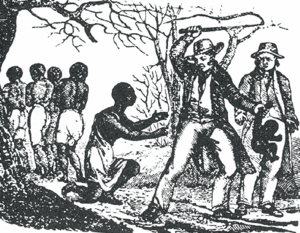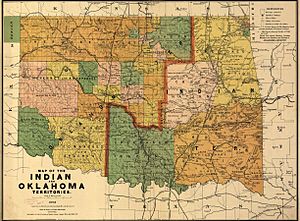History of slavery in Oklahoma facts for kids
The history of slavery in Oklahoma began in the 1830s. This was when five Native American nations moved to what was then called Indian Territory. These nations were the Cherokee, Chickasaw, Choctaw, Creek, and Seminole. Slavery in these tribes was different from the slavery practiced in other parts of the United States. It continued to grow for many years, even during the Civil War. After the Civil War ended, slavery also ended in the Oklahoma area. New treaties were made with the Native American nations about citizenship and rights for African Americans. The effects of slavery had a big impact on the state, leading to many challenges related to race.
Contents
How Slavery Began in Oklahoma
In 1830, the Indian Removal Act forced several Native American nations to leave their homes in the South. They had to move to new lands further west. This new land would later become Oklahoma. The Cherokee, Chickasaw, Choctaw, Creek, and Seminole nations moved to this territory.
When these nations moved, they brought African Americans with them, including enslaved people. This was the start of slavery in the area that became Oklahoma. For example, when the Cherokees moved, about 10 to 15 percent of their group were African Americans. Some of these were free Black people. This was one reason they were forced to move from their old lands. Their territory had become a safe place for enslaved people to escape to. Slave owners in the South wanted to stop this.
Over time, slavery grew in the Indian Territory. The Choctaw and Chickasaw nations, especially, became very involved in owning enslaved Black people. They had learned about slavery in Mississippi before they moved. After the Indian Removal Act, they continued to buy and sell enslaved people.
Understanding Slavery in Native American Nations
Native American tribes had a long history of taking people as captives. They might take a captive to replace a family member or servant they had lost. These captives would often do labor. For example, among the Creek Indians, captives were treated almost like prisoners of war. However, over time, they could sometimes improve their status and even become part of the family that owned them.
As European influence grew, some Native Americans began to join the Atlantic slave trade. They started owning Black enslaved people. If a Native American woman married an African man, he and their children would be free. They could also gain respect within the community.
After the American Revolution, the Cherokee signed the Treaty of Holston in 1791. This treaty encouraged the Cherokee to live a farming-based life. The United States offered to provide them with basic supplies, including enslaved people for farm work. Many Cherokee people with European heritage used enslaved labor. While some full-blooded Cherokee also owned enslaved people, most slaveholders had European backgrounds. They learned about the benefits of slavery from their families.
For many years, these enslaved people provided labor, helped with relationships, and translated for settlers. They became a part of Indian culture and history. Because enslaved people often did work traditionally done by women, some tribes saw them as lower in status. The change from traditional captive-taking to chattel slavery (where people are treated as property) is debated. Many believe it happened because of assimilation. This means tribes adopted European ways, sometimes to avoid being forced off their land. Tribes became more "westernized" as Europeans and Americans moved through their lands. Leaders of mixed race backgrounds also gained power.
In 2017, a federal court ruled that African Americans who were descendants of those enslaved by the Cherokee were allowed to become tribal citizens. This meant they had the same rights as other tribal members.
1842 Slave Escape
In 1842, on the Joseph Vann plantation, enslaved people took action. They locked their enslavers in their homes and took supplies. This group of 35 people escaped. They met up with enslaved Creek people and headed towards Mexico, where slavery was against the law. However, a Cherokee-ordered group of fighters caught or executed the runaways.
The Civil War and Slavery
The American Civil War (1861-1865) greatly impacted slavery in the Indian Territory.
- The first Confiscation Act was passed in August 1861. It said that the Union army could take property used to support the rebellion. Much of this "property" was enslaved people. A second act in July 1862 allowed the seizure of property from those against the Union. It also said that enslaved people captured by the Union would be set free. However, these laws were not fully put into action. President Abraham Lincoln was worried that too much pressure would cause more states to leave the Union. Also, freeing enslaved people in Confederate areas could only happen where the Union army had control. Still, these laws showed that slavery was a key reason for the war. Battles were fought in Indian Territory to protect the right to hold enslaved people.
- Cabin Creek was an important location in Indian Territory. It was near the Texas Road, a supply route for both Union and Confederate armies. Two Civil War battles happened here.
- The first battle was in July 1863. Confederate troops tried to capture a supply train. Union soldiers crossed the creek and eventually pushed the Confederates back. The First Kansas Colored Infantry, made up of Black soldiers, fought alongside white soldiers for the Union. This was a significant moment.
- The second battle happened in September 1864. Confederate soldiers surprised the Union at night. They captured 300 wagons. The First and Second Cherokee regiments, the First and Second Creek regiments, and the Seminole Battalion fought with the Confederacy. They successfully captured 130 wagons and 740 mules. The Second Battle of Cabin Creek was the last Civil War battle fought in Indian Territory.
After Slavery: Reconstruction and Challenges
The end of the Civil War affected each of the Five Nations differently. In 1866, as part of new treaties, the United States government required Native American nations to free their enslaved people. Not all nations immediately stopped slavery. It ended slowly in some areas.
Three of the five nations ended slavery right after the Civil War. However, the Choctaw and Chickasaw nations did not. Nations that governed themselves did not feel an immediate need to end slavery. So, it took longer for these two nations to abolish it. It was not until the next year that both nations signed a treaty to end slavery.
Even after enslaved people were freed, some former enslavers were still harsh. Many Native Americans and African Americans struggled to understand what equality and freedom truly meant. This made race a constant topic in Oklahoma's history. People also struggled to understand citizenship.
During the time of Reconstruction, many Black towns were formed in the Indian Territory. There were more Black towns here than anywhere else in the United States. These towns were created to give African Americans a chance to live freely in their own communities, away from white control. The challenges of Reconstruction led to segregation, or the separation of people by race. Segregation was common, especially in schools, in the late 1800s. Each county made its own decisions about segregation.
The Tulsa Race Massacre
In the 1910s, Tulsa was a major center for the oil industry. The oil boom helped Greenwood, the African American part of Tulsa, to grow and become very successful. It was even called "Black Wall Street."
On May 30, 1921, Dick Rowland, a young Black man, entered an elevator. He was helped by Sarah Page, a white female elevator operator. After he left the elevator, Page claimed that Rowland had acted improperly towards her. Even though the police did not charge Rowland, newspapers spread rumors. A crowd gathered outside the Tulsa County courthouse jail. Some people wanted to harm Rowland, while others wanted to protect him.
Shots were fired, and 12 people died. More shootings and damage to property happened throughout the day. Tensions grew worse in the first week of June. Machine guns and even planes were used to attack Greenwood. The goal was to destroy the community. In total, over 1500 homes were burned or looted.
After receiving a message from Tulsa's mayor, the Red Cross came to Oklahoma. They treated the people of Greenwood as if they were prisoners of war, providing aid. The Red Cross stayed in Tulsa for months, leaving on December 31, 1921.





